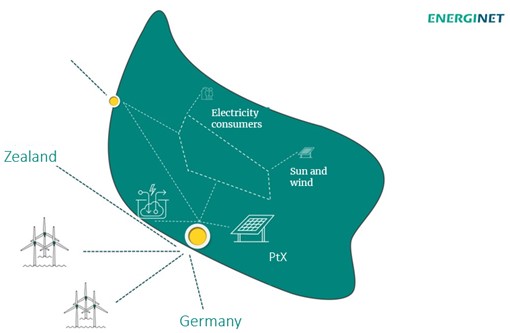
The new EU Renewable Energy Directive (RED), agreed upon by the member states in March, also includes cross-border projects and in this regard requires each member state to develop a legally binding framework.
Denmark and Germany have now met this requirement with the signed intergovernmental agreement.
The two countries’ agreement regulates sharing of the renewable target quantities from Bornholm Energy Island and counting the capacity towards the German targets under the country’s Renewable Energy Sources Act (EEG) and towards the German and Danish contributions to the EU target under the EU Renewable Energy Directive.
Bornholm Energy Island, located in the Danish sector of the Baltic Sea, will facilitate connecting at least 3 GW of offshore wind generation capacity to the grid by the early 2030s. The electricity will then be transported via new grid connections to Germany (2 GW ) and to the Danish mainland (1.2 GW).
The transmission system operators (TSO) 50Hertz and Energinet agreed in advance that they would each assume half of the infrastructure costs of the project. In return, the TSOs will share the congestion proceeds from the respective lines to Germany and Denmark and will each receive ownership of the (inter)connector to the respective mainland.
In a press release issued on 1 June, the German Ministry for Economic Affairs and Climate Action said the legally binding agreement was the cornerstone for the implementation of Bornholm Energy Island and that this project was a milestone for the concrete implementation of the declarations of the heads of state and governments of the North Sea countries in Esbjerg in 2022 and Ostend in 2023.
The Danish government approved the development of two energy islands, Bornholm Energy Island and North Sea Energy Island, back in 2020. The following year, the government and the TSO Energinet started exploring increasing the initially planned capacity of 2 GW for Bornholm Energy Island to 3 GW.
In the summer of 2022, the Danish government and the country’s political parties signed an agreement on expanding the planned offshore wind capacity to 3 GW. At the same time, Denmark and Germany entered into an agreement to jointly build a subsea connection that will run from the energy island to Germany.
This year, Denmark has been working to finalise the process and the requirements for tenders it plans to run by the end of this year, including that for offshore wind farms at Bornholm Energy Island.
Only a day before the Danish-German agreement under the EU RED, the Danish government entered into an agreement with a broad majority of the country’s parties that secures the framework for the upcoming auctions.
Under this political agreement, the so-called “overplanting” option was agreed upon, which could bring more offshore wind capacity than planned, Bornholm Energy Island included, where 3.8 GW could be connected with overplanting allowed.